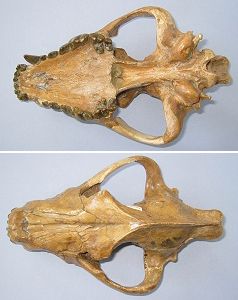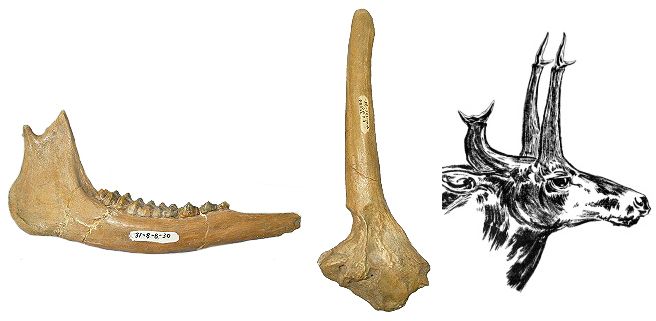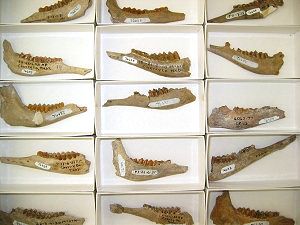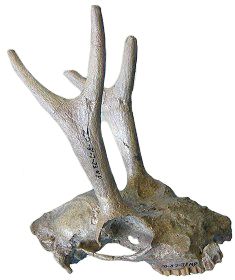
Nebraska County Fossils
Cherry
< Vertebrate Paleontology Home
A virtual journey through the Museum's vertebrate paleontology collection.
Aelurodon "platyrhinus" =Aelurodon ferox, Flat-nosed Cat-toothed Dog
Family: Canidae
Geologic age: Miocene (Late Barstovian), about 13.5 million years old
Year fossil collected: 1915


Aelurodon platyrhinus was a member of the canid or dog family. The genus Aelurodon was the most abundant of the medium-size carnivores of the Middle Miocene. Less specialized than the cats and the "bear-dogs", Aelurodon was somewhat similar to modern dogs...but some species were quite a bit larger. Merycodus may have been a popular meal for Aelurodon. It takes a large number of prey to support any carnivore population, and fewer than one carnivore fossil is found for every hundred herbivores. Aelurodon means "cat-toothed", so called because this dog had an extra cusp on the slicing tooth in the upper jaw, like cats.
Cranioceras skinneri, Skinner's three-horned deer
Family: Dromomerycidae
Geologic age: Middle Miocene (Barstovian), about 13.5 million years old
Year fossil collected: 1930

Primitive "deer" diversified in the Miocene to include some very odd forms. This species, named for famed fossil hunter and paleontologist Morris Skinner of Ainsworth, had two "horns" over the eyes and a single "horn" on the back of the skull. Cherry County was Morris' favorite fossil hunting ground, and it was also a favorite haunt of Cranioceras.
Merycodus, Pronghorn
Family: Antilocapridae
Geologic age: Middle Miocene (Barstovian), about 13.5 million years old
Year fossil collected: 1933


Merycodus was the common pronghorn "antelope" of the Middle Miocene of Nebraska. Rocks of this age are especially well exposed in Cherry County. The jaws and pronged horns of this grazing herbivore are often found, but complete skulls and horns are rare. Huge herds of pronghorns must have roamed the plains of Nebraska between 13 and 16 million years ago, just as they did in pioneer days.
Geological Ages of Rock Formations

| Q | Pleistocene ("Ice Age") Sands, gravels, silts overlay much of the county (not shown) Pleistocene sands, gravels and silts overlay much of Nebraska and often conceal the bedrock beneath. These "Ice Age" deposits often produce the remains of mammoths, bison, horses, musk oxen, elk and other familiar mammals. Small fossils, especially, are important indicators of the climate at the time of deposition. |
| Tpo | Tertiary, Miocene/Pliocene, Ogallala Group, 2-14 million years old Ogallala Group rocks include predominantly clastic sands and sandstones composed of a mixture of Rocky Mountain debris and locally derived and re-worked sediments. Ash beds are not unusual in the Ogallala and help to precisely date the sediments. In western and southwestern Nebraska, the Ogallala beds are responsible for resistant bluffs that cap the valley sides of modern streams. |
| To | Tertiary, Oligocene, White River Group, 28-40 million years old The White River Group rocks include the Chadron and Brule Formations often form large expanses of low to medium-relief badlands typical of western Nebraska (Toadstool Park) and South Dakota (Big Badlands). Siltstones and very fine sandstones dominate these units. The White River Group rocks preserve the early history of horses, rhinos and camels, all of which originated in North America. The habitats across much of the state at the time were distinctly un-Nebraskan, with low-crowned browsing mammals (forest dwellers) and their predators composing the dominant fauna. |





